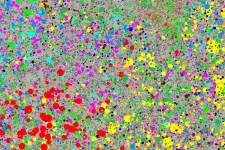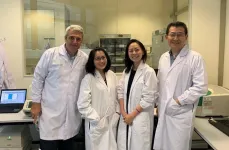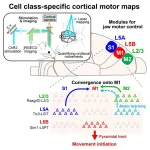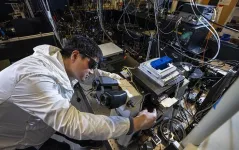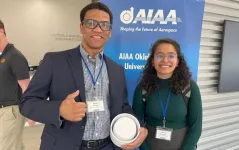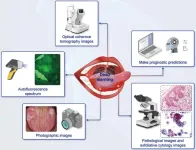(Press-News.org) Laying the groundwork for quantum communication systems of the future, engineers at Caltech have demonstrated the successful operation of a quantum network of two nodes, each containing multiple quantum bits, or qubits—the fundamental information-storing building blocks of quantum computers.
To achieve this, the researchers developed a new protocol for distributing quantum information in a parallel manner, effectively creating multiple channels for sending data, or multiplexing. The work was accomplished by embedding ytterbium atoms inside crystals and coupling them to optical cavities—nanoscale structures that capture and guide light. This platform has unique properties that make it ideal for using multiple qubits to transmit quantum information-carrying photons in parallel.
"This is the first-ever demonstration of entanglement multiplexing in a quantum network of individual spin qubits," says Andrei Faraon (BS '04), the William L. Valentine Professor of Applied Physics and Electrical Engineering at Caltech. "This method significantly boosts quantum communication rates between nodes, representing a major leap in the field."
The work is described in a paper published on February 26 in the journal Nature. The lead authors of the paper are Andrei Ruskuc (PhD '24), now a postdoctoral fellow at Harvard University, and Chun-Ju Wu, a graduate student at Caltech, who completed the work in Faraon's lab.
Just as the internet connects the classical computers we are accustomed to using today, the quantum networks of the future will connect quantum computers that exist in different physical locations.
When working with the quantum realm, researchers are dealing with the miniscule scale of individual atoms and of photons, the basic particles of light. At this scale, matter does not behave according to classical physics; instead, quantum mechanics are at play.
One of the most important and bizarre concepts in quantum mechanics is that of entanglement, where two or more objects such as atoms or photons are inextricably linked regardless of their physical separation. This connection is so fundamental, that one particle cannot be fully described without reference to the other. As a result, measuring the quantum state of one also provides information about the other, which is key to quantum communication.
In quantum communication, the goal is to use entangled atoms as qubits to share, or teleport, quantum information. The key challenge that has thus far limited communication rates is the time it takes to prepare qubits and to transmit photons.
"Entanglement multiplexing overcomes this bottleneck by using multiple qubits per processor, or node. By preparing qubits and transmitting photons simultaneously, the entanglement rate can be scaled proportionally to the number of qubits," says Ruskuc.
In the new system, the two nodes are nanofabricated structures made from crystals of yttrium orthovanadate (YVO4). Lasers are used to excite ytterbium atoms (Yb3+), a rare-earth metal, within these crystals, causing each atom to emit a photon that remains entangled with it. Photons from atoms in two separate nodes then travel to a central location where they are detected. That detection process triggers a quantum processing protocol that leads to the creation of entangled states between pairs of ytterbium atoms.
Each node has many ytterbium atoms within the YVO4 crystal, so there are plenty of available qubits. However, each of those atoms has a slightly different optical frequency caused by imperfections within the crystal.
"This is like a double-edged sword," Ruskuc says. On one hand, the differing frequencies allow the researchers to fine-tune their lasers to target specific atoms. On the other, scientists previously believed that the corresponding differences in photon frequencies would make it impossible to generate entangled qubit states.
"That's where our protocol comes in. It is an innovative way to generate entangled states of atoms even when their optical transitions are different," Ruskuc says.
In the new protocol, the atoms undergo a kind of tailored quantum processing in real time once the photons are detected at the central location. The researchers call this processing "quantum feed-forward control."
"Basically, our protocol takes this information that it received from the photon arrival time and applies a quantum circuit: a series of logic gates that are tailored to the two qubits. And after we've applied this circuit, we are left with an entangled state," Ruskuc explains.
The team's YVO4 platform can accommodate many qubits—in this work, each node contained approximately 20. "But it may be possible to increase that number by at least an order of magnitude," says co-author Wu.
"The unique properties of rare-earth ions combined with our demonstrated protocol pave the way for networks with hundreds of qubits per node," Faraon says. "We believe this work lays a robust foundation for high-performance quantum communication systems based on rare-earth ions."
Additional Caltech authors of the paper, "Multiplexed Entanglement of Multi-emitter Quantum Network Nodes," are graduate student Emanuel Green; AWS Quantum Postdoctoral Scholar Research Associate Sophie L. N. Hermans; graduate student William Pajak; and Joonhee Choi of Stanford University, a former postdoctoral scholar from Faraon's lab. Device nanofabrication was performed in the Kavli Nanoscience Institute at Caltech. The work was supported primarily by the Air Force Office of Scientific Research and IQIM, a National Science Foundation Physics Frontiers Center at Caltech that receives support from the Gordon and Betty Moore Foundation. Additional funding came from the NSF.
END
Multiplexing entanglement in a quantum network
2025-02-26
ELSE PRESS RELEASES FROM THIS DATE:
Bacteria consumed by immune cells become part of the cell
2025-02-26
Immune cells that eat bacteria in the body don’t stash them in specialized compartments as once thought, but turn them into critical nutrients that build proteins, create energy and keep the cells alive, according to a new study from scientists at the University of Colorado Anschutz Medical Campus.
“We are what we eat,” said the study’s co-senior author Angelo D’Alessandro, Ph.D., professor of biochemistry and molecular genetics at the University of Colorado School of Medicine at CU Anschutz. “What we eat changes the composition of us and when immune cells eat bacteria the same thing happens to them.”
The ...
CSIC researchers discover how the brain builds sophisticated maps to navigate and remember the world
2025-02-26
The brain creates internal 'maps' to help us navigate and learn from our surroundings, but how these maps form remains a challenge to understand. Now, a study led by Liset M. de la Prida at the Cajal Neurosciences Center (CNC-CSIC) in Madrid, in collaboration with Imperial College London, offers a fresh perspective on how spatial and experiential information is encoded in the hippocampus, a key brain region for navigation and memory.
The study published today in Neuron, reveals that two types of hippocampal ...
New spatial mechanism for the coexistence of tree species
2025-02-26
The data sets are very large: with more than 75 permanent forest dynamics plots in 29 countries worldwide, the Forest Global Earth Observatory network (ForestGEO) of the Smithsonian Tropical Research Institute (STRI) provides excellent forest inventories for investigating the dynamics of forest ecosystems and better understanding the processes that drive the structure and function of forests. On these 20-to-50-hectare plots, every single tree with a diameter not much larger than a pencil has been identified, measured and mapped every five years, often totalling more than 200 000 trees. The two UFZ researchers, Dr. Thorsten Wiegand ...
City of Hope research features myeloma study, cancer surgery and more
2025-02-26
This roundup highlights a common drug that can help treat multiple myeloma, a paper analyzing the benefit of a colorectal surgery follow-up test, recommendations for implementing remote patient monitoring for care received before, during and after surgery, details on how often women with an elevated breast cancer risk are receiving enhanced screenings, and clinical trial results for a new chimeric antigen receptor (CAR) T cell therapy targeting B cell acute lymphoblastic leukemia.
To learn more about research at City of Hope, one of the largest and most advanced cancer research and treatment organizations in the U.S. with its ...
A*STAR spin-off NalaGenetics implements nationwide drug reaction screening for leprosy patients in Indonesia
2025-02-26
SINGAPORE – NalaGenetics, a spin-off from A*STAR Genome Institute of Singapore (A*STAR GIS), will be transforming leprosy treatments in Indonesia with a nationwide genetic screening programme with their PGx1301 diagnostic kit. Set to launch in the fourth quarter of 2025, this initiative builds on a successful five-year pilot test in East Indonesia, which demonstrated the effectiveness of precision medicine in preventing life-threatening adverse drug reactions (ADRs).
As part of this programme, up ...
Unraveling the brain’s hidden motor modules
2025-02-26
For nearly a century, scientists have known that different parts of the human brain’s cortex control different body movements. This fundamental discovery dates to the 1930s, when neurosurgeons used electrical stimulation to map how different cortical regions correspond to different body parts.
But can these regions be further broken down into even smaller functional components? Researchers have long suspected that cortical units for specific body movements are more complex than simple patches in the cortex. Studies have identified various types of neurons stacked in multiple layers across the neocortex, but without a clear picture of how these ...
New photon-avalanching nanoparticles could enable next-generation optical computers
2025-02-26
A research team co-led by Lawrence Berkeley National Laboratory (Berkeley Lab), Columbia University, and Universidad Autónoma de Madrid has developed a new optical computing material from photon avalanching nanoparticles.
The breakthrough – which the team published recently in the journal Nature Photonics – paves the way for fabricating optical memory and transistors on a nanometer size scale comparable to current microelectronics. This approach offers a path toward realizing smaller, faster components for next-generation ...
Current status and future perspectives on early detection and diagnosis of colorectal cancer in China
2025-02-26
Colorectal cancer (CRC) is the second most commonly diagnosed cancer in China and a leading cause of cancer-related mortality. Despite improvements in treatment, the survival rate remains lower than in Western and other Asian countries due to late-stage diagnosis. Given that CRC typically develops over a prolonged period from precursor lesions, early detection and timely intervention are crucial for improving patient outcomes. However, CRC screening in China faces several challenges, including regional disparities, economic constraints, and limited public awareness. Recent advancements in non-invasive diagnostic tests, innovative imaging techniques, and ...
Program’s expansion boosts student research opportunities
2025-02-26
Aerospace engineering senior Philip Wilson attended an American Institute of Aeronautics and Astronautics (AIAA) conference. Rohit Raut, a senior physics major, presented his work at a nuclear research symposium, and senior biology major Jaden Rankin had the opportunity to feature her research at an entomology conference.
These and other University of Texas at Arlington students were able to showcase their original research at major symposiums thanks to UTA’s expansion of its popular undergraduate research program that provides funding for select students to present at academic conferences.
“At the conference, I presented my work on rotating ...
Deep learning in the diagnosis and prognosis of oral potentially malignant disorders
2025-02-26
Oral cancer remains a serious global health concern due to its high morbidity and mortality rates, primarily caused by late-stage diagnosis. The presence of oral potentially malignant disorders (OPMDs) provides an opportunity for early intervention, as these lesions precede the development of oral squamous cell carcinoma. However, the accurate detection and classification of OPMDs remain challenging due to their diverse clinical presentations. Conventional diagnostic methods, including visual examination and histopathological ...

